Lessons & Units
A database
of lessons and units searchable by content and cultural standards,
cultural region and grade level. More units will be available soon.
You can use Acrobat Reader to look at the PDF version of the Cover
Sheet
for the Units and Self-Assessment
for Cultural Standards in Practice.
BEAVER

A Cultural Mini-unit
Beaver In Interior Alaska
|
Author:
|
Iditarod Area School District Donna Miller MacAlpine
|
|
Grade Level:
|
K-3
|
|
Context:
|
Two to three weeks in spring, during beaver trapping
season
|
|
Region:
|
Interior Athabascan
|
|
Goals:
|
1. To have students become familiar with the physical
characteristics of beaver and to know why these are important to the beaver's
way of life.
2. To have students become familiar with
the beaver's habits and habitat: life cycle, food, shelter,
environment.
3. To have students become aware of both
the historical and present day importance to the
beaver.
4. To have students become familiar with
some traditional stories and beliefs about the
beaver.
5. To increase oral and written language
skills in English, and in the local Native language where
practical.
6. To develop basic science and math
skills and precepts within the local cultural
setting.
|
The selected Alaska Content Standards for Science
and Math and the Cultural Standards for Students which are addressed
by this unit are identified and the skills and knowledge which are
expected as learning outcomes are listed under the
standards.
TO THE TEACHER
Introduction:
This Cultural Mini-Unit, Beaver in Interior Alaska
for K-3, supplants an earlier Iditarod Area School District unit
prepared for K-6 by Linda Deardorff in 1984. Many parts of this unit
are borrowed from that previous unit, but in this newer version
developed under the Alaska Rural Systemic Initiative, additional
activities have been included to emphasize the study of math and
science in the local cultural setting.
The unit as used in the Iditarod Area School District is in
the form of a learning kit including lesson material, reference books, puppets,
tapes, beaver food and cuttings and beaver bones, teeth and pelt.
The written material presented here is part of the Kit Notebook
and includes the Goals of the unit, Alaska Standards addressed, and a section
including learning objectives and activities for each of the first four goals.
Goals five and six will be met by activities throughout the unit.
The sections are directly related to the goals and are as follows:
1) physical characteristics
of the beaver
2) habits and habitat
3) economic importance
4) stories and beliefs about
beaver
A Resource List is also included and references are made to
various materials within the activities. Some of the supplementary pages are
reproduced here but there are many more only in the actual kit notebook.
Using This Unit:
The basic unit may be covered in a two or three
week period, but could be expanded to cover the whole quarter. It is
suggested that this unit be presented in the spring while local
people are trapping and that local elders and trappers be invited to
share their experiences with the students as often as
possible.
There are no lesson plans as It is expected that
each teacher will take the materials and information included in the
unit and arrange them as best fits the specific grade level and group
of students being taught.
Although the unit is designed for use in the
primary grades, many of the ideas and activities may be suitable for
upper grades.
It is suggested that the teacher begin a personal
collection of beaver material. Use what is presented here to start a
beaver notebook, and put together your own beaver kit. Develop your
own math and science projects based in the local
community.
There are many more materials available than those
on the resource list, many more activities and ideas you can use, but
your best resources will be the people of the community, mainly the
elders, who will be able to tell the students things about beaver and
about the traditional way of life which they will not find in any
books.

ALASKA STANDARDS
The goals, learning objectives and activities of
this unit address the Alaska Science and Math Content Standards and
the Cultural Standards for Students outlined as follows:
SCIENCE: A student who meets these standards
should
A-7 - understand how the
earth changes because of plate tectonics, earthquakes,
volcanoes, erosion and deposition, and living things (Processes
that Shape the Earth);
A- 14 - understand (A)
-
the interdependence between living
things and their environments;
A-15 - use science to understand and
describe the local environment (Local Knowledge);
B-1 - use the processes of Science; these
processes include observing, classifying, measuring,
interpreting data, inferring, communicating, controlling
variables, developing models and theories, hypothesizing,
predicting, and experimenting;
D-3 - recommend solutions to everyday
problems by applying scientific knowledge and
skills;
Skills and Knowledge to be acquired by the
student:
1) Students will be able to list the beaver's adaptive
characteristics and to indicate how each helps the beaver to survive.
2) Students will be able to list the things necessary in
an ideal beaver habitat and to give local examples of such.
3) Students will be able to give examples of the changes
beaver can make in the environment.
4) Students will be able to draw/build a model beaver lodge
and to describe its distinctive characteristics.
MATH A student who meets these standards
should:
A-3 - perform basic
arithmetic functions, make reasoned estimates, and select and
use appropriate methods or tools for computation or estimation
including mental arithmetic, paper and pencil, a calculator,
and a computer;
A-4 - represent, analyze, and use
mathematical patterns, relations, and functions using methods
such as tables, equations, and graphs;
C-1 - express and represent mathematical
ideas using oral and written presentations, physical materials,
pictures, graphs, charts, and algebraic expressions;
E-2 - use mathematics in daily
life;
Skills and Knowledge to be acquired by the
student:
1) Students will be able to perform basic arithmetic
functions, to estimate and to choose appropriate tools to solve simple problems
involving beaver.
2) Students will be able to use math to calculate receipts
and profits from beaver trapping, production of artifacts from beaver parts
and other business transactions.
3) Students will know by experience that math is a useful
tool in solving daily problems.
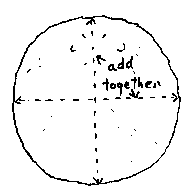
CULTURAL STANDARDS A student who meets these standards should:
A-4 - practice their
traditional responsibilities to the surrounding
environment.
C-1 - perform subsistence activities in ways
that are appropriate to local cultural traditions;
E-2 - understand the ecology and geography
of the bioregion they inhabit;
Skills and Knowledge to be acquired by the
student:
1 Students will know how to
treat beaver according to local custom.
2 Students will know the traditional
importance of beaver in the local economy.
3 Students will know the importance of
beaver in the local bioregion.
4 Students will be able to indicate on a map
of the local area the places where beaver are traditionally
found.
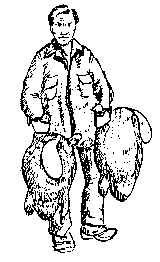
BEAVER - Resource
List
Children's Books
The Beaver, Nentl- Crestwood House,
1983
The Beaver, Lane
- Dial
Press, 1981
The Life Cycle of the Beaver, Hogan
-
Raintree, 1979
The Beaver, How he Works, Rounds -
Holiday House, 1976
A Beaver Tale, Rebel Williams
Busy Beavers, M. Barbara Brownell
-
National. Geographic
Tendi Goes Beaver Snaring, Macdiarmid
- Dept. of
Ed., NW Territories, 1972
Trouble in Beaver Hollow, Moran
- Holt,
Rinehart and Winston, 1973
Benjamin Beaver's Box, Jones
Story Collections
Animal People, NBMDC
How Stories from Alaska, NBMDC,1978 ("How
the Beaver Got His Tall")
Hunters of the Northern Forest, Richard
Nelson ("Beaver", Chapter 16)
When People Meet Animals, Partnow
- ANEB
("The Female Beaver", p.4)
Tetlin As I Knew It, Jimerson
- ANEB,
1975 (Wintertime: Beaver Camp)
Old Beliefs -
Upper Kobuk, NBMDC
Eagle Han Huch'inn Hodok by Ruth Ridley, ANLC ("The
Beaver's Friend, ...)
Reference Books
Beaver Trapping, Charlie Wulf
- ALL
Project, 1974
Resource Guide for Beaver Bulletin Board Kit,
Kit Cache, Wasilla, AK
Album of North American Animals, Dugdale
- Rand
McNally & Company, 1966
Alaska Mammals, Alaska Geographic. Vol. 8, No. 2
Make Prayers to the Raven
,
Richard Nelson -
U. of Chicago Press, 1983
Hunters of the Northern Forest, Richard
Nelson -
U. of Alaska, 1982
Dena: The People, U. of Alaska
Tracks: C'ek'e, Copper River School
District, 1981
The North American Beaver Trade,
Cobblestone, June 1982
Section 1: Physical Characteristics of the Beaver
Goal: To have students become familiar with the physical characteristics
of the beaver and know why these are important to the beaver's way of life.
Objectives:
1. Students will identify the beaver as a
rodent and point out certain characteristics which make it easily
recognizable (size, flat tail, chisel like teeth, small ears,
webbed hind feet, fur etc.)
2. Students will list each of the beaver's
special adaptations (split claw, clear eyelid, etc.) and its
specific purpose.
3. Students will be able to tell why the
beaver's physical characteristics are important to the beaver's
way of life.
Activities:
1. Introduce the beaver by asking how many students have
seen a beaver. What can they tell you about it? Discuss what they know
about
a beaver and how It lives. (See page 1-a, "Learning About Beaver" as a guide
to this Introduction.)
2. Show drawings or photographs of beaver. Show a film about
beaver. Read to the class about beaver. Sections of either The Beaver or
The Beaver: How He Works are suitable for this.
3. Let students examine a beaver or beaver parts (real or
model) and note special features or adaptations. It will generate a lot of
interest if a local trapper can bring in a beaver carcass for students to
look at.
4. Make a large drawing of a beaver and label the parts.
This can be done both in English and in the Native Language. (See page l-b
for example.)
5. Have students relate each
physical characteristic of the beaver to something specific that the beaver
does to survive. Let them make their own chart or make a large wall chart.
(See page 1-d for example.)
6. Demonstrate how "Oil and water don't mix!" for the
students, page 1-c. Have the students prepare reports (oral or written)
on this experiment.
7. Do "Let's Draw a Beaver", make a beaver puppet or
do another suitable art activity emphasizing the shape and parts of a beaver
(pages l-e
and 1-f).
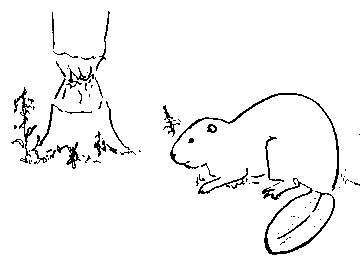
|
LEARNING ABOUT BEAVER
|
1-a
|
Some questions to consider in introducing the
topic beaver.
1) What kind of an animal is a beaver?
2) How and where do beaver live? Are there any
around here? Where?
3) How do you catch a beaver?
4) How do you skin a beaver?
5) What are the different ways of stretching the
skin? Why do you stretch it?
6) What are the different ways of tanning
the skin?
7) What things do people make out of beaver
skin?
8) What parts of the beaver do people cook and
eat?
9) What other parts of the beaver do people use,
and for what?
10) What are the traditional beliefs or taboos
about beaver?
11) Are there traditional stories or songs about
beaver?
LABEL THE PARTS

PHYSICAL CHARACTERISTICS
- Notes to
the teacher
You can emphasize the importance of the beaver's physical characteristics
by asking students such questions as:
1) What would happen if a beaver lost his tail?
2) What would happen if the beaver couldn't oil his coat?
3) What would happen if a beaver broke his tooth and it wouldn't
grow again?
4) What would happen if a beaver didn't have the little flaps
of skin to close behind his teeth?
Experiment: Oil and water don't mix!
Have the student's speculate as to
-why beaver don't get soaking wet when
they spend so much time in the water?
-what keeps them from getting really cold in
the icy water?
The beaver has oil glands under its tail.
When beaver groom themselves, they spread the oil through their
fur to make it waterproof The water never gets near their skin.
That's how they can stay dry and warm even in cold water. Wet fur
would conduct heat away from the body. Since the fur doesn't get
wet, the warmth stays in.
How can the oil keep them from getting
wet?
Here is an experiment to show to the
class how the oil keeps the beaver from getting wet.
1) Put some cooking oil in a bottle. Pour water
on top and shake. Gradually the oil and water will separate and
the water will sink to the bottom. Oil and water don't
mix!
2) Pour some oil on a piece of construction
paper so it soaks into a large area. Pour some water on top of the
oil. The water will form globules or will run off. This is what
happens when water touches a beaver's oiled fur. Oil and water
don't mix!
|
Beaver characteristic
|
Why is this important?
|
|
strong, stocky body; short, thick neck
|
allows beaver to move heavy logs
|
|
strong, flat, paddle-shaped tail
|
acts as a rudder when swimming acts as a prop when beaver
cuts tree slaps water to give warning
|
|
two layers of thick fur
|
undercoat is soft & fine for warmth guard hairs
protect undercoat
|
|
teeth
|
|
|
- incisors with very hard
covering
|
allow beaver to cut through wood
|
|
- keep growing all the time
|
beaver would die without good teeth
|
|
- molars
|
grind up what beaver eats allow beaver
|
|
- space between incisors and
molars
|
to carry sticks by mouth
|
|
front paws have flexible fingers
|
used like human hands to pack & pat mud, hold
and move sticks
|
|
back feet are webbed
|
used for swimming
|
|
one split claw on each back foot
|
used for grooming
|
|
nose and small ears have watertight valve
|
close when beaver dives under water
|
|
eyes have a clear eyelid
|
beaver can see under water
|
|
special flap of the lip can close behind teeth
|
keeps water, wood chips out of throat when chewing under
water
|
|
oil glands under tail
|
allows beaver to oil fur to keep dry
|
LET'S DRAW A BEAVER
What shape is a BEAVER? In this simple activity
you can reinforce student's knowledge of shapes.
Draw on the board a circle, a larger half circle
and an oval. Ask students to identify these shapes. Then have
students draw these shapes on their papers and turn them into a
beaver. They can also add tiny circles for eyes, little triangles for
ears, and little rectangles for teeth. And don't forget to add some
feet!
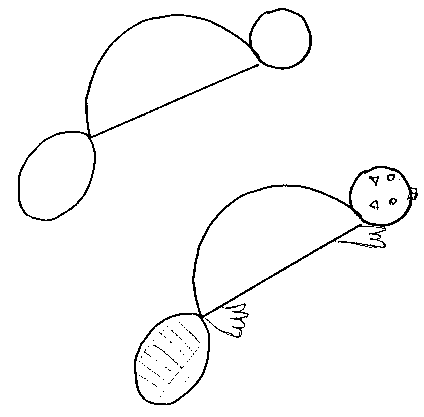
MAKING A PAPER BAG PUPPET
|
Materials:
|
brown paper bags 8"-10" tall. (#8 is good) shredded
or crushed up paper for filling
pattern for set of head, tail, feet -
(double the size of pattern below and copy this
onto brown construction paper)
pattern for teeth (double
size)
crayons, glue, scissors,
stapler
|
|
Method:
|
1) Give each student a paper bag and material to stuff
it. When the bag is stuffed, fold the top over and staple it.
2) Give each student a set of head, tail,
etc. Tell them to color and then cut out the parts. Tail can
be lined to look like scales. Teeth should be cut out of
white paper and colored orange.
3) Glue the head and both sets of feet on
the front of the bag. Glue the tail on the back.
|
Puppets can then sit up on a table or shelf or, if
a hole is punched in the top of the head, can be hung by yarn to look
as If they are swimming around. Students drawings of lodges, trees
and a beaver pond make an effective background.

Section 2: Habits and Habitat
Goal 2: To have students become familiar with the beaver's
habits and habitat: life cycle, food, shelter, environment.
NOTE: There are several pages of background
information for the teacher included in this section, pages 2-b,c,
d.
Objectives:
1. The students will describe the life cycle of the beaver.
2. The students will describe the beaver's house and how
it is built.
3. The students will list and identify the types of food
eaten by beaver.
4. The students will tell how a beaver's habits help protect
it from enemies.
5. The students will describe beaver habitat: land form,
vegetation, other animals and birds found there, etc.
6. The students will list some of the problems that occur
when beaver and people live too close together and will be able to suggest
some solutions.
7. Students will do simple math problems related to beaver
habits and habitat.
Activities:
1. Read with the class The Life Cycle of the Beaver.
(see page 2-a for Study Guide.) Discuss the life cycle of the beaver.
2. Discuss what a beaver house looks like and how it
is built. Have students color the picture of the beaver and babies in their
lodge. (This
is taken from the ADF&G coloring book, 1978: Where the Animals Live.)
3. Invite an elder or other community member to the class
to talk about beaver. Find out where beaver live in the area and where people
from the community have traditionally trapped beaver. Record this information
on a map of the local area.
4. Read about what a beaver eats. Take a field trip to collect
samples of beaver food. Examine the food samples you have collected. Peel
off the bark and taste the different kinds of sticks. List and describe the
types of food. What are the variables which might affect a beaver's diet?
5. Discuss how you would know if you were near a live beaver
lodge. What signs would you look for?
If possible visit a beaver lodge on a pond or river bank
and have students develop their skills of observation. Look for beaver tracks
and trails, beaver cuttings and trees that have been felled (How new do they
look?), a feed pile near the house and other signs that beaver are living
close by.
Describe what was observed and what can be inferred from
the observations.
6. Brainstorm about beaver habitat; what environment does
a beaver need to survive? Have students list the components of an ideal beaver
habitat.
7. Make a mural of a beaver pond showing the dam, lodge,
vegetation and other creatures which live there. Include the beaver signs
observed in the previous activity or do the BEAVER HABITAT project described
on pg. 2-d
8. Build a "beaver lodge", instructions on page 2-e.
In this activity students will not only learn about the construction of
a
lodge but
also how hard beavers have to work!
9. Discuss what happens when beaver and people live too close
together. List the problems and then try to suggest one or more solutions
for each. Ask the elders of the community about beaver problems and solutions.
If available, read Trouble in Beaver Hollow, a fictional story about
how a young beaver and a young boy deal with the problem of litter in a beaver
stream.
10. Do the PUZZLERS on page 2-f, g
The Life Cycle of the
Beaver
by Paula Z. Hogan
Study Guide: Read the story or have
students listen to the tape. Then ask the following
questions:
|
Page
|
Questions
|
|
5
|
Who can tell me where beaver live? (lakes,
river, ponds)
|
|
6
|
How are beaver's bodies well built for
swimming? (strong bodies, webbed back paws, tail for steering)
Does the water hurt their
eyes? (Note: the book does not point this out so be sure to
tell students that a beaver does not close his eyes. He has
a special cover to protect his eyes underwater and also
special closings to protect his ears and nose. Also there is
a special flap behind their front teeth so they can chew
under water.)
|
|
9
|
Who remembers what else beaver use their
back paws for? (to comb their fur.) Note: The beaver has a special split
toenail on his back paw designed just for grooming.
|
|
11
|
How many babies does the mother beaver
have in the spring? (three or four)
What are baby beaver called?
(kits)
|
|
12
|
What do beaver eat? (green plants, twigs,
tree bark)
|
|
15
|
With what do the beaver build their dams?
(sticks, grass, mud, stones)
|
|
19
|
What does a beaver do for a warning signal
when there is danger? (slaps his tail on the water)
|
|
20
|
When do beaver leave their first home?
(when 2 years old)
|
|
25
|
How does the beaver get into his house?
(He uses a tunnel that opens underwater.)
|
|
27
|
How do beaver get food in winter? (from
a pile of sticks they put under the water in front of their house in
the summer)
|
|
29
|
When do beaver start a new family? (Kits
are born in April or May.)
|
|
30
|
What is the name of the large group of
animals beaver belong to? (rodents)
Name some other rodents.
(muskrat, mouse, squirrel)
|
Study Guide prepared by Linda D.
Deardorff for Beaver Mini-Unit, 1984
HABITS AND HABITAT - General
information
What are the beaver's enemies or predators?
Hungry wolves, wolverines and bears will attack beaver on land.
Otters sometimes go right into beaver lodges and
attack the beaver.
Hawks, owls, eagles and foxes go after the kits on
land.
People who want beaver for meat or fur set traps
or snares or even shoot beaver.
How does a beaver protect himself from
enemies?
Beavers are primarily nocturnal. They do most of
their work at night and so are not easy to see.
They build very strong lodges to keep out
predators. The lodges usually have more than one tunnel.
Beaver have refuge holes along the bank where they
can go to rest or hide.
Beaver try to stay close to the water so they can
dive and swim. They build their dams to make the water deeper and
safer.
If a beaver senses danger, he warns others with a
slap of his tail.
How does a beaver survive the cold Alaskan
winter?
Beaver store lots of branches in feed piles under
the water close to their lodge so they can swim to these under the
ice.
Beaver can breathe in their lodges because there
is always a small air hole at the top. When they are in the water
there is a layer of air under the ice where they can
breathe.
Beaver lodges are very thick and strong and can
keep out the cold. The beaver has very warm fur which he keeps
oiled.
BEAVER HABITAT
Beaver have a greater effect on their environment than most
animals. When they move into a new area they can cause drastic changes. In the
same way, if a beaver dam is broken and can't be fixed or the beaver decide
for some reason to leave the area, once again there is a great change over the
following years. When beaver live in inhabited areas they can do a lot of good,
but also a lot of damage as they work to change the environment.
Why do the beaver build dams?
They build dams to back up the water and make It deeper. They
need deep water
- to hide the entrance tunnels to the
lodge.
- so the water won't freeze to the bottom
and they have room to swim under the ice
- to store their food.
- to dive into to protect themselves from predators.
What happens to the surrounding area when a
beaver builds a dam?
The water spreads out and the surrounding area is
flooded.
Existing trees and other vegetation will die but
new types of vegetation will grow.
A large area around the pond may become marshy.
New birds and animals will move into the area.
What other creatures live around a beaver
pond?
- other rodents: squirrels, mice
muskrats
- birds: ducks, swans, snipes, etc.
- frogs, insects
- weasel, mink, marten
- moose and other animals come to drink and
feed
What happens if the dam is broken and the pond
drains?
The change will be much more gradual than when the
dam was built. Slowly the pond will become smaller and shallower and
different animals will live there. The surrounding area which was
only marshy will dry out and the forest will start to move in.
Eventually where the pond was will be a grassy meadow or a patch of
willows. If the pond was built by damming a stream, the stream may
still run through the area.
What happens when beaver live too close to
people?
Sometimes beaver do a lot of good. Their dams help
conserve water, stop erosion and prevent Hoods. The ponds that they
form help other wildlife survive.
Beavers living near people can also do a lot of
damage:
1) Dams flood cropland and pasture, roads, railway
tracks.
2) Hungry beaver can destroy orchards, tree farms
and nurseries and even get into people's gardens.
3) Occasionally a tree felled by a beaver will
smash a roof or power lines.
4) In rural areas where people get their water
from a pond or creek they may catch giardia or "beaver
fever"
HABITAT PROJECT: Have students make a set of
drawings (murals?) to show an area 1) before the beaver come, 2)
while the beaver live there, 3) long after the beaver have
gone.

LET'S BUILD A BEAVER LODGE
(Thanks to Judy Kuhn, K-1 at McGrath School, for
this idea)
If you are doing this project with young students,
the platform will need to be built ahead of time. It might make a
good shop project for high school students. The following is only
meant to be a guide. Use your imagination!
Parents can be asked to take their students out to
gather willows and deliver them to the school the week before the
lodge is to be built.
If the platform is well built it can be stored and used
year after year or you may want to leave the whole structure up for a while.
If
it
is inside it can be used as a reading corner, or if It is outside it could
serve as a "playhouse" for students.
|
Materials:
|
2 sheets of heavy plywood 4' x 8' for platform
2' x 4's for octagonal frame
2 x 4's or 2 x 6's for legs and braces
under frame
piles of willows, 1-1/2" or smaller in
diameter, 4-8' long
rope or heavy tape
tools: nails, hammer, drill,
saw
|
|
Method:
|
Make the Platform
- build an octagonal form about 7' diameter with the
2x4s
- put plywood sheets together and cut to form circle
with 8' diameter
- cut a hole near center for students to climb in through
- drill holes for willows around edge of circle
(1-1/2"),
12" apart
- put on legs so it will be about 3' above the ground
Add Willows
- stick a sturdy willow, at least 6' long, in each hole
- tie these together at the top
- begin to weave willows horizontally around the outside,
in and out of the uprights
- straighten the willow structure as necessary and weave
to the top, pulling in the uprights if necessary
|
BEAVER PUZZLERS
1) How many beaver is too many?
Presume that a pair of beaver have four surviving young each
year for four years. What if the young ones stayed with their parents and didn't
leave when they were two years old? How many beaver would live in the house
after four years?
Why don't all the beaver remain in the same house
or even in the same pond? What would probably happen if they
did?
2) How long can you hold your
breath?
Did you ever wonder how a beaver can stay under
the water so long? Beaver can swim for up to half a mile underwater.
Usually beaver only stay under water for two or three minutes but can
last up to 15 minutes if they have to.
When a beaver dives under water its heartbeat and
circulation slow down. That means it needs less oxygen and its breath
can last longer.
Tell your students to try this!
First of all estimate how long you think you can
hold a breath. Write the estimate down on a piece of
paper.
Then take a deep breath and hold it as long as you
can. Let it out slowly, but don't take in any more air. Watch the
second hand on the clock. How long can you last? The average person
can hold his breath only about 15-20 seconds. Make a graph to show
how long the students can hold their breath compared to a
beaver.
3) How deep is the water?
It is said that beavers need at least 3 feet of
water in their pond all year round to survive.
a) If the water level of the pond drops 1 foot in
winter when It freezes, how deep would the water have to be in
summer?
b) If the floor of the lodge is 1 foot above the
level of the water in summer, how far above the water will it be in
winter?
c) If the water is 6 ft. deep at one end of a pond
and 2 feet deeper at the lodge, how deep is it around the
lodge?
4) How far does Buddy Beaver swim?
Buddy Beaver is having a busy morning. He is out
very early while it is still dark and is helping repair the beaver
dam. He swims from his house to the shore and cuts down a small birch
tree. Then he pulls it through the water to the dam where Big Beaver
uses it to help plug one of the holes. Buddy swims back and gets
another little log, and then back again to the dam. Now he is hungry
so he swims to a patch of willows on the other side of the pond.
After he eats he sees that the sun is already up so he goes back to
his house to take a nap.
a) Look at the picture and figure out how far
Buddy swam this morning.
b) If Buddy made three trips back to get logs for
the dam and then went straight home, how far would he have to
swim?
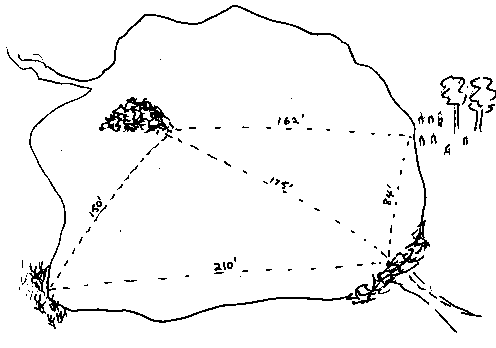
Section 3 Economic Importance of Beaver
Goal: To have students become aware of both the historical
and present day importance of beaver.
Objectives
1. Students will know why the beaver was an important animal
for the Native people of Alaska.
2. Students will describe the historical importance of the
beaver in the opening of the West and North in the 19th and early 20th century.
3. Students will list several important uses of beaver today.
4. Students will be familiar with various methods of catching
beaver, and with how the skins are prepared for use or for market.
5. Students will do simple math problems dealing with the
use and marketing of beaver.
Activities:
1. Discuss why beaver was such an important animal
to the Native people long ago. List the various traditional uses of
beaver. Make a chart relating the use to the part of the beaver used.
(See "Uses of Beaver", 3-a)
2. Read the introduction to The Beaver, pages 4-7. Discuss
why the beaver was of such importance in the early history of our country. Were
beaver of the same importance in the opening of the interior of Alaska? Were
there any early trading posts in your area?
How is beaver used today? Does it still have the same importance?
3. Read about beaver camp or trapping
beaver:
- "Beaver Camp" from Tetlin as I Knew It
- Tendi Goes Beaver Snaring
- Beaver Trapping
4. Invite an elder or other community member to come to
class and talk about beaver trapping. Have students prepare
some questions ahead of time.
5. Have students list ways beaver can be caught.
Examine a snare and a trap.
6. Discuss ways of preparing beaver meat. Cook and
eat some beaver.
7. Review drying and tanning methods. Compare
commercially tanned skins with home tanned. Look at Items made with
beaver fur.
8. Do the "BEAVER PUZZLERS" starting on page
3-b.
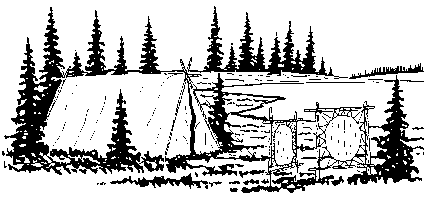
USES OF BEAVER
(Compiled during the Dinayetr week in Shageluk, AK, May 1996)
|
Clothing:
|
Beaver hats, beaver mittens, beaver coat or vest, trimming
for slippers and boots
|
|
Blankets:
|
Skins used to be cut in strips and woven or braided to
make blankets.
|
|
Food:
|
Beaver meat can be boiled or roasted.
Beaver feet can be boiled or pickled.
Beaver tail can be boiled or
roasted.
The head, feet and tail and be boiled and
cleaned to make "beaver cheese".
|
|
Tools:
|
Traditionally beaver teeth were made into chisels and
draw knives for working on wood.
|
|
Other:
|
Beaver teeth can be decorated with beads and hung on
the wall.
Beaver feet can be skinned and the skin
made into a little bag.
Beaver castors are used for bait for
trapping.
Certain beaver bones were used to test a
person's strength.
Beaver claws were sometimes made into
necklaces.
|
PUZZLERS 3-b
|
Sizing and selling beaver pelts
The size of a beaver pelt is determined by adding together
the number of inches across the pelt from top to bottom and from side
to side.
|
|
|
SIZING
|
|
PRICE LIST
|
|
small
|
0-52"
|
$15.00
|
|
medium
|
53-59"
|
$20.00
|
|
large
|
60-64"
|
$25.00
|
|
blanket
|
65-70"
|
$30.00
|
|
super blanket
|
over 70"
|
$35.00
|
Information from Beaver Trapping by C.
Wulf.
Look at the sizing chart and the list of prices. Answer the
questions.
John caught three beaver. After he stretched and dried them,
he measured them.
|
1st pelt
|
32" long by 30" wide
|
|
2nd pelt
|
35" long by 34" wide
|
|
3rd pelt
|
24" long by 20" wide
|
How much could he sell his beaver pelts
for?
b) Billy also got three beaver. After he stretched and dried
them, he measured them.
|
1st pelt
|
34" long by 31" wide
|
|
2nd pelt
|
28" long by 26" wide
|
|
3rd pelt
|
32" long by 30" wide
|
How much could he sell his beaver pelts for?
c) Who earned more money, Billy or John? How much
more?
d) Borrow some stretched beaver pelts. Measure
them. What size are they?
2) Making Beaver Hats
Suzy likes to sew. She has some skins she tanned from beaver
her husband trapped for food. Now she wants to make some hats to sell. She wonders
how much profit she would make on each hat. Help her figure it out.
Suzy estimates it would take her about 16 hours to make a hat.
If she pays herself $10.00 an hour, how much would that be in wages? (She doesn't
count the time It took to tan the skins.)
|
Wages for sewing
|
|
_______
|
|
Now add to that the cost of
|
- cloth for lining
|
$6.00
|
|
|
- thread, yarn etc.
|
$3.50
|
|
|
Total cost of the hat
|
__________
|
a) If she sells the hat for $250.00, how much profit is she
making?
b) If she had to buy the beaver skin for $30 and
pay $30 to have it tanned and the other expenses were the same, how
much profit would she make?
Even if Suzy makes a very small profit on the sale
of a hat, why do you think it would still be worthwhile for her to
make and sell hats? What else could she do with the skins she has
tanned?
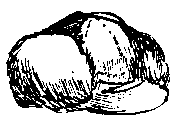
3) What Is a Beaver Worth?
Charlie had been told by his elders that when you catch an
animal, nothing is ever wasted. He got a beaver and wondered how many things
he could make out of it. He also wondered how much money he could get out of
one beaver.
Here is what he did:
He skinned the beaver and sold the pelt for
$30.00. After cutting off the head and feet, he sold the carcass to a
dog musher for $25.00. He took the feet and sold them to his Uncle
Joe for $5.00. (Charlie knew he really should give them to his uncle,
but he also knew Uncle Joe loved to eat beaver feet and was willing
to pay because he couldn't go out trapping himself.)
Charlie boiled the beaver head and took out the teeth which
he sold to Auntie Alice for $3.00. She was always trying to get beaver teeth
to use in making ornaments for people to buy and hang on the wall.
a) How much money did Charlie make from his beaver?
b) If it cost him $12.00 for gas to trap one beaver, how much
profit did he make?
c) Can you think of other things he could have
done to make more money from that one beaver?

Section 4 Traditional Stories and
Beliefs
Goal: To have students become familiar with some traditional
stories and beliefs about beaver.
Objectives:
1. Students will know that in many cultures it is believed
that long ago animals were people and could change back and forth and that
many of their present characteristics came from things that happened to them
at that time.
2. Students will retell one traditional story about the beaver.
3. Students will know why it is important to have respect
for animals, and how that respect is shown for the beaver.
4. Students will relate several traditional beliefs about
beaver.
Activities:
1. Read Animal
People or a similar story to the
class to introduce students to the idea that long ago animals could
take human form and that many of their present characteristics come
from things that happened then.
2. There are several types of traditional beliefs about
beaver. As with other animals their signs could be read to foretell weather
or some
coming event. There were also beliefs about how you should
treat beaver, or what will happen if you show disrespect.
Read "Beavers" from Old Beliefs -
Upper Kobuk, pg. 4-a. This is not from interior
Alaska but is a good introduction to a discussion of local beliefs. Also look
at the "Beavers" page from Beliefs from Nikolai, pg. 4-b.
Discuss traditional beliefs in the Athabascan culture. Why
is It important to respect these beliefs nowadays? (For more background information
refer to Make Prayers to the Raven, p.136-138)
3. Invite an elder to class to tell a traditional story about
beaver and some of the traditional beliefs. Ask them if there are any special
ways that beaver should be treated.
4. Read one or more of the following traditional stories about
beaver:
- "Porcupine and Beaver" (source unknown), pg.
4-c
- "Porcupine, Beaver and Bear" (source unknown),
pg. 4-d
- "The Female Beaver" from When People Meet
Animals, pg. 4-e
- "Beaver-Man Story" from The Yukon, pg.
4-f
Another good story: "How the Beaver Got His Tail" Is found
In How Stories of Alaska.
Discuss the different types of traditional stories
and the purpose of these stories. (to teach behavior, explain the
natural world, entertain, carry on a tradition, etc.)
5. Have students write their own story about how the beaver
got one of his distinguishing physical characteristics.
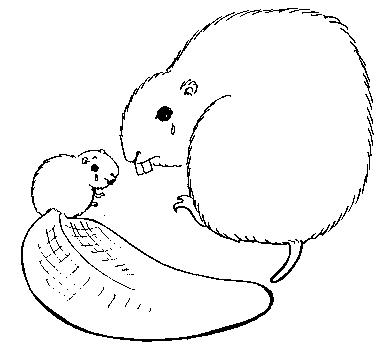
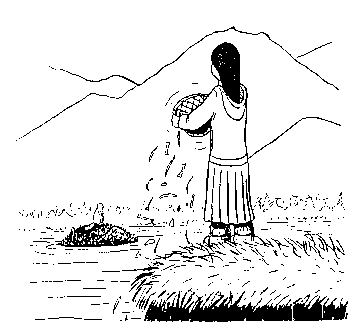
Beavers from Old
Beliefs - Upper
Kobuk
We trap beaver for food and for clothing. They are also very
useful in preventing floods when the spring thaw comes. The following are some
of our beliefs about them.
1. If
someone is out trapping for beavers, he must be sure not to use ugruk,
bearded seal, or seal ropes. If he does, he will
never get a beaver.
2. After someone catches a beaver, he must take off the little
thin bones on the sides of the feet and throw them away. He must also remove
the overlapping toenails and throw them away. Only after he does this can he
go home. He does this to make sure that he will be able to catch beavers more
easily on his next trapping trip.
3. Whenever a beaver is eaten, all its bones must be thrown
back into the water from which it came. This is done in order to make sure that
the spirit of the beaver is returned to its place. It is the only thing to do
in order to catch beavers more easily in the next trapping trip.
BEAVERS from
Beliefs from Nikolai
If the beaver built a small house and stored little food, a
short winter was expected. If he built an extra big house, a long winter was
coming.

Porcupine and Beaver
NOTE There are many versions of this story told all over Alaska. They tell
how Grandma porcupine wanted to get across the river and was finally taken by
beaver. In this version the fire she makes leaves a permanent mark on beaver's
tail.
Porcupine was walking up and down the river bank. Every once
in a while she would stand up and stare across the river and sniff the breeze
that blew from the other side. Porcupine was on an island.
"Oh, if I only could get to the other side of the
river. But I'm too old and fat. I would never make it." porcupine
thought. She curled up into a ball because her stomach hurt so bad,
and started to cry.
"Why porcupine! Why are you crying on such a
beautiful day?" asked muskrat.
Porcupine stood up and looked. It was muskrat
swimming along the river. As he swam toward her, porcupine said, "Oh,
muskrat, I can't get to the other side of the river and I'm so
hungry. I've eaten all the bark and leaves from the trees and I can't
swim.'1
"Well porcupine I could take you: across, just hop
on my tail." said muskrat.
"Oh, muskrat could you?" Porcupine asked and wiped
away her tears with her paws. Then she wobbled over to pick up her
cooking pot and sticks. She returned and was about to perch on
muskrat's tail.
"Why muskrat? I can't sit on your tail it's as
skinny as a rope I'd fall off and drown!"
"Rope! You call my tail a rope? Well you can stay here then," and
off he swam down the river.
Porcupine crumbled to the ground. She started crying again.
Whistle! What was that? Again whistle! Slowly she lifted her head and was staring
into the eyes of mink.
"Why porcupine! Why are you crying on such a
beautiful day as this?" asked Mink.
Porcupine stood up and looked. It was mink
swimming along the flyer. As he swam toward her porcupine said, "Oh,
mink I can't get to the other side 6f the river. I'm so hungry, I've
eaten' all the bark and leaves from the trees and I can't
swim."
"Well porcupine I could take you across. Just hop
on my tail" said mink. Porcupine remembered muskrat's tail. She
looked down and said, "Why mink! Your tail is as skinny as a willow!
I can't ride on your tail."
"Willow! You call my tail a willow? Well you can
stay here then," and off he swam down the river.
Porcupine crumpled to the ground again and started
crying. Whistle! What was that? Again whistle! Slowly she lifted her
head and was staring into the eyes of otter.
"Why are you feeling so down porcupine?" asked
otter. At which porcupine sobbed even louder.
"Nothing could be that bad!" said
otter.
"I cannot get to the other side of the river. I have nothing
to eat over here," said porcupine.
"Well hop on my tail and I'll bring you over. Porcupine remembered
mink's tail. She looked down. "Why otter! Your tail is as skinny as a stovepoker."
"Stovepoker? You call my tail a stovepoker! Well you can just
stay her then," and off he swam down the river.
By now porcupine was really feeling hungry. She went over to
her cooking pot and licked the inside, there was nothing. Her stomach started
growling and cramping it hurt so bad. She curled into a ball and rocked back
and forth.
All of a sudden, slap! Oh, no what was that? Porcupine curled
up even tighter. I hope it's not going to eat me she thought. Slap! again.
"PO-PO-porcupine! How come you-your crying?" asked Beaver.
Slowly porcupine looked up. It was beaver. He had been swimming
along the river when he noticed porcupine all curled up.
"Oh, beaver I'm so hungry! And I can't swim to the other side.
I'm too old and fat. Beaver just look up here, do you see anything for me to
eat?" asked porcupine. Beaver stood on his hind legs and looked, he couldn't
see anything, for he was nearsighted.
"W-w-well just get on my tail, I'd be h-h-happy to take you
over" said beaver.
She went to look at his tail. "Oh Beaver! Thank you, thank
you!" Porcupine grabbed her cooking pot and sticks and sat on beaver's tail
and away they went.
Porcupine was so happy! Hmm, hmm. hummed porcupine. The
closer they got to the other side, she thought to herself, "Oh, I'd
better start my water so it will be ready when we reach the other side and
all I
have to
do is gather bark. Yes, broth, that's what I need.' First she got a bucket
of water, and then made a fire on beaver's tail. Hmm, hmm. hummed porcupine.
All
of a sudden beaver slaps his tail! Porcupine fell into the water! Cooking pot
and all.
"B-b-beaver! There's water in my ears," said porcupine.
"Well cover your ears!" said beaver.
"B-b-beaver! There's water in my eyes," said porcupine.
"Well close your eyes!" said beaver.
And down to the bottom of the river she sank. She
started climbing through weeds and over logs and rocks. Finally she
reached the shore choking and coughing. "Why did you slap your tail?
I could have drowned!" asked Porcupine.
"Well why did you -
start a fire on my tail?" asked beaver and
away he swam down river.
Porcupine shook herself and started up the bank, she sniffed
the air. "Why, I'm on the other side of the river," she thought.
And to this day when you look at beaver's tail
you'll see a dark spot in the middle of his tail, where porcupine had
started the fire.
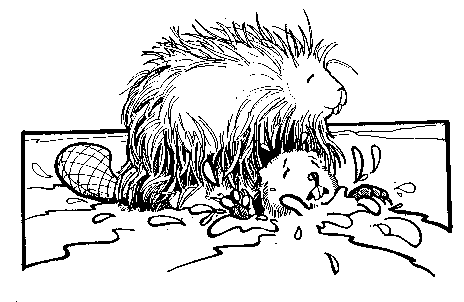
Porcupine, Beaver and Bear
There was a time when both Beaver and Porcupine were afraid
of Bear. Then, one day, Bear started chasing Porcupine. Porcupine climbed a
big spruce tree. Bear climbed up after him. Porcupine climbed higher and higher.
So did Bear. Porcupine climbed way up into the tippy top of that tree. So did
Bear. Now he could catch Porcupine. Bear reached out his paw to grab Porcupine.
Porcupine slapped Bear's paw. Now it was full of quills. Quickly, Porcupine
swung his tail again. Bear reached up with his other paw so that Porcupine would
not slap him in the face. But now Bear was not holding on. He fell out of the
tree. Bear fell down, down, down to the ground. He landed on his head and broke
his neck. He died.
Word spread about how Porcupine had killed Bear.
It was in the middle part of Alaska, the Interior where the
Athabascan people live, that Porcupine killed Bear. Word spread to
the West and North coast of Alaska, by the Bering Sea and the Arctic
Ocean, where the Eskimos live. Now bears living there were afraid of
porcupines, too. Word spread to the Alaska Peninsula and onto Kodiak
Island. Now all those bears were afraid of porcupines. Word spread
clear down to Southeast Alaska, that strip of land that looks like a
pan handle. That is where the Tlingit people live. That is where this
part of the story takes place.
Now in those days, Beaver and Porcupine were best friends.
They were a lot alike. They were both rodents with great big incisor teeth.
With those big front teeth, they ate the same kind of things. They both used
their tails when they were in danger. But in some ways, they were not the
same.
Beaver was afraid of Bear and Porcupine was not. Only Porcupine could climb
trees. Only Beaver could swim. One day, Porcupine and Beaver were out in
the
forest together. They were munching on tasty twigs and leaves and bark. They
saw Bear coming down the mountain. "Oh, no. Oh, no!" cried Beaver. This is the
end of me. Bear will eat me for sure." "Don't worry," said Porcupine. "I will
protect you. I will slap Bear with my quills." "Bear will go around you to get
me. Oh, what will I do? I am too far from my lodge in the pond to hide there."
"Then climb a tree." said Porcupine. "You know I can't climb trees," said Beaver.
"Then I will help you," sighed Porcupine. Somehow, Porcupine pushed Beaver up
in a cottonwood tree. It was hard to do. Then he started back down. "Friend,
where are you going?" called Beaver. "I am going to finish my lunch," said Porcupine.
"But how will I get down?" asked Beaver. "Getting down is easy. You can slide
or you can jump." Said Porcupine. Porcupine waddled off. Beaver did not want
to slide down. He did not want to jump down. He was afraid he would get hurt.
Bear was far away now. Beaver wanted to get down. Beaver started calling, "Help!
Somebody! Please get me down!" Beaver called for a long, long time. Nobody
came.
He started to eat all the branches he could reach. Soon
the tree was bare all around him. He was out of food. He began to call for
help
again. No one came. He was beginning to think he would be stuck there and
starve
to death. Then Squirrel came. "I'll help you," said Squirrel. "How can you help
me?" asked Beaver. "You are much too small." "You start sliding down. I will
hold onto your tail with my teeth. 1 will hold onto the tree with the claws
on my four paws. I will not let you fall." "I don't think it will work," said
Beaver. "Would you rather starve to death?" asked Squirrel. Beaver decided
to go down. Squirrel helped him. When Beaver slid down, he made deep grooves
in
the smooth bark of the cottonwood tree.
Beaver scurried back to his pond-. He swam and swam and
swam. He was very glad to be back. Later that day Beaver saw Porcupine walking
by
the pond. "Come and visit me," Beaver called to Porcupine. "You know I cannot
swim," said Porcupine. "I will help you," said Beaver. "Just put your head on
my tail and hang on. I won't let you get wet. I have all kinds of yummy things
for you to eat at my house." Porcupine liked yummy things to eat so Porcupine
put his head on Beaver's tail and hung on.
Beaver started swimming. Then he started diving. He dived
again and again. Porcupine hated getting wet. When Beaver came up, Porcupine
would
yell, "Stop! Stop that! Stop diving! You'll drown me!" Beaver acted like he
didn't hear. He kept diving. Porcupine could not swim. He had to hang onto Beaver's
tail. If he let go, he would drown. Beaver took Porcupine to an island and left
him there. The island was not Beaver's home. There was nothing to eat there.
Now Porcupine started calling. "Help! Somebody! Please get me out of here!"
Porcupine called for a long, long time. He was beginning to
think he would be stuck there and starve to death. Then Wolverine came. Wolverine
made the cold North wind blow. The pond froze over and Porcupine walked to shore.
After that, Beaver and Porcupine stopped being friends. And so it is, to this
day, that Beaver and Porcupine still are not friends. And also, to this day,
Bear is still afraid of Porcupine and Beaver is still afraid of Bear. And the
cottonwood tree still has deep, deep grooves in its bark.
The Female Beaver from When People
Meet Animals
There is a Koyukon story that the old
people used to tell to their grandchildren on winter nights, when
all the children were warm between fur blankets. The fire in the
middle of the winter sod house would be burning low and the smell
of the smoke would blend with the smell of fresh spruce boughs
covering the floor.
The story went something like this:
A young man was coming home from a hunting trip late one winter
day. He had been walking through deep snow all day and was very tired, but decided
to keep walking until he got back to camp. He walked and walked, but didn't
see any of the familiar signs of home. He suddenly realized that he was lost.
It was dark by now, but he kept walking, hoping that he
would find the camp of another band. Then, he saw a fire through the trees
There was
a camp ahead, next to a lake. He started running toward
it, and when he got to the camp, was happy to see people, at last!
The man was greeted by the people. They told him that though
they looked like people to him, they were really beavers He had strayed out
of human territory and into beaver land.
The young man was very tired. He looked around at the beavers'
camp. He saw a pretty young woman next to one of the houses. Although he knew
she was really a beaver, he decided to take her as his wife and to stay in the
beaver camp. He lived there all winter long, with his new wife and her relatives.
When spring came, the young man knew that it was
time to go back to his own home. But springtime is the time of
hunger, and the beavers had no extra food to send with the young man
for his trip home.
The beaver-people talked it over. They could not
give the man food from their caches, but they decided they would let
him take one of their children as food for his trip.
The young man's wife offered to be killed. She
would become food for her husband and keep him alive.
Her parents looked at their son-in-law and said to him. "When
you have finished with the meat, you must throw the bones into the water, and
say 'Tonon Litseey'." This means "be made again in the water".
The young man agreed, and set off for his home
village with the beaver meat. The man got home safely, thanks to the
meat he had been given. When he had eaten it all, he threw the bones
into the water and said, "Tonon Litseey.
Suddenly the female beaver who had been his wife appeared
in the water where he had thrown the bones. She swam away to her parents
lodge.
The old people would end their story by
saying, "And ever since that time, we have followed the custom of
throwing beaver bones into the water after we have eaten the
meat."
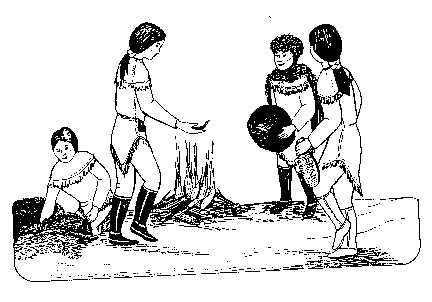
Beaver-Man Story
This story was originally told by Mrs. Martha Taylor,
Dawson City, Yukon Territory, Canada and
is found in the book The Yukon by Richard
Matthews.
One time long ago, Beaver Man he's traveling
around, a-traveling and a-traveling. The sun he was real hot, and Beaver-Man
he got thirsty, you know, real thirsty like when you don't get even spit to
swallow. He need something to drink real bad. One man he's a-traveling with,
he fall down dead he so thirsty.
Beaver-Man pretty soon he say to himself, "What I going to do?" And he start thinking, and pretty soon he say to the people
he's a traveling with, "I going to make you some water so you better get ready
to drink."
Then Wolverine say, "There's no water. How you going to
make some?" and they all get mad at him, think he's crazy, just want to make
big show. Especially Wolverine, he's real mad.
Beaver-Man he take and cut willow stick
and he tie willow stick to his walking stick with a piece of... how you say
in English?.. that string you make from caribou. Then he go down in a little
valley, at the top end of it, and he say again, "I going to make you some
water, so you better get ready to drink."
Then he stick willow stick into ground.
Pretty soon lot of water coming out. Lot of, lot of water from good clean spring.
All these people with Beaver-Man, even Wolverine, they so happy they put their
whole head right in the water.
After that each time Beaver-Man
and his people they get thirsty, he go up to top of little valley,
stick in willow stick, and water come out. Lot of water. He done this
many times. Each spring it make a stream, and after long, long time
these streams so many they big enough to make Yukon. All that, it
happens long time ago. That' s the end of the story.
Addition from an Educator (8 Oct 2009)
Hi,
I just wanted to write and say thanks for your Lesson plans. I run science
workshops Cree students in Northern Quebec. The beaver workshop was
a great way to use knowledge the kids already had to present curriculum
concepts like ecology and physical adaptation. The kids are surprised
at how much science they already know.
At the beginning of the lesson
I pass around a beaver skull (left over from a feast) since the students
really like concrete, hands-on stuff.
I also made a board game about beaver adaptations which you can use
if you like ([board game and tokens]).
It can be printed on two 11x17 pages I found that
the lesson worked well with grades 4-7. Amiskw is the Cree word for
beaver.
Sincerely,
Alanah Heffez
Montreal, QC |
Handbook
for Culturally Responsive Science Curriculum by Sidney Stephens
Excerpt: "The information and insights contained in this document will be
of interest to anyone involved in bringing local knowledge to bear in school
curriculum. Drawing upon the efforts of many people over a period of several
years, Sidney Stephens has managed to distill and synthesize the critical ingredients
for making the teaching of science relevant and meaningful in culturally adaptable
ways." |